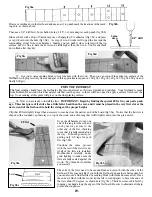
_____13. Make yourself a long sanding block now, us-
ing a flat board about 2-3” wide and at least 16” long.
Apply double-stick carpet tape to the flat face of the
sanding block, covering the face the full 16” length (fig
13a).
Cut coarse sandpaper (60 grit) to match the width of
the board and press the clean side down against the tape
(fig 13b). You can add to the length of the sandpaper by
pressing a second piece in place at the end of the first.
Fig 13b
Fig 13a
_____12. This is a good time to open up the slot for the tenon
in the heel block so it looks like fig 12a below. You could do
this by hand with a sharp chisel and/or razor knife, but we use a
router with a flush trim bit (fig 12b). The goal is to trim away
all rib material that covers the pre-cut slot in the heel block.
Pencil hash-marks on the kerfing around body, as shown
in fig 13c.
Then use your flat sander to level the entire front edge of the
frame. Keep the sanding block flat by always having both ends
resting across the instrument, as shown in fig 13d.
The pencil marks should all be cleaned off by this sanding work.
Keep sanding until they are all removed.
Fig 13c
Fig 13d
7.
Fig 12a
Fig 12b
Summary of Contents for PARLOR
Page 36: ......



























